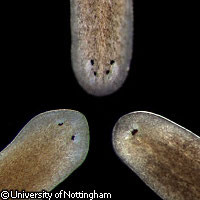Worm gives up its secret to body part regeneration
UK scientists have discovered the clever gene behind the planarian worm's ability to regenerate its own head, brain and other body parts after amputation. The ability to mimic this remarkable natural phenomenon could one day make the regeneration of damaged human organs and tissues possible. The study is published in the journal Public Library of Science (PLoS) Genetics. One of biomedical science's most important long-term objectives is to understand the genetic basis of 'remaking' or regenerating tissue from adult structures. In their paper, the research team from the University of Nottingham note that the ability to regenerate is widespread in animals, allowing scientists to study evolution's answers to coordinating this process. The university's Dr Aziz Aboobaker explained that even a very simple worm offers us a great opportunity to understand tissue regeneration. 'We want to be able to understand how adult stem cells can work collectively in any animal to form and replace damaged or missing organs and tissues. Any fundamental advances in understanding from other animals can become relevant to humans surprisingly quickly,' said Dr Aboobaker. Planaria have a population of stem cells that can divide rapidly, allowing them to generate different kinds of missing cell types after amputation, such as muscle, gut, and brain cells. The mix of genes active in these stem cells and the remaining tissue are then able to manage the regeneration process so that the new structures are the right size, shape and orientation, and end up in the right place. The process culminates into a fully functional organism once again. Thanks to this new research, we now know that the 'Smed-prep' gene is largely responsible for this extraordinary ability. The gene is specifically required to 'coordinate the regeneration of the planarian brain, arguably the most exciting part of planarian regeneration,' the scientists write. PhD student and co-author of the study Daniel Felix said that understanding the molecular basis for tissue remodelling and regeneration is critical to regenerative medicine. 'Planarians are famous for their immense power of regeneration, being able to regenerate a new head after decapitation. With the homeobox gene Smed-prep, we have characterised the first gene necessary for correct anterior fate and patterning during regeneration.' Dr Aboobaker added that knowing what is taking place when tissues are regenerated under normal circumstances, scientists can begin to formulate how to replace damaged and diseased organs, tissues and cells safely in the event of trauma or disease. This information could lead to new treatments for Alzheimer's disease, for example, he pointed out. 'With this knowledge we can also assess the consequences of what happens when stem cells go wrong during the normal processes of renewal - for example in the blood cell system where rogue stem cells can result in leukaemia,' concluded Dr Aboobaker.
Countries
United Kingdom



